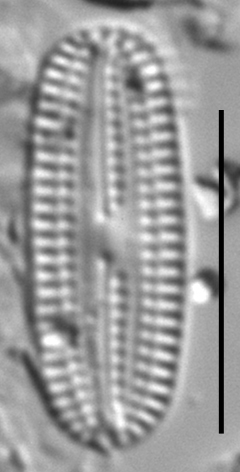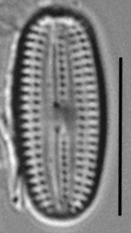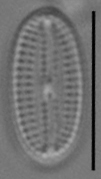Fallacia tenera
-
Category
-
Length Range9.4-15 µm
-
Width Range4.5-7 µm
-
Striae in 10 µm16-21
-
SynonymsPseudofallacia tenera (Hust.) Lui et al. 2012
-
ContributorRosalina Stancheva - May 2018
-
ReviewerIan Bishop - May 2018
Identification
Description
Valves are linear-elliptic to elliptic. The axial area is straight, narrow and contains a filiform, straight raphe. A narrow, lanceolate lyre-shaped hyaline area is present on either side of the axial area. The striae are radiate to nearly parallel and composed of distinct areolae. Striae are interreupted longitudinally by a hyaline rib, which divides the striae into two areolae. The areolae closer to the mantle are larger, one per stria, and uniform in shape and size. The inner areolae are smaller, one per stria, and uniform in shape and size. The central area is small. Areolae adjacent to the raphe branches form a single row on one side, but sometimes there are a few areolae or an incomplete row of areolae on the other side of the raphe.
The presented concept of F. tenera is strictly based on observations of the type material of Navicula tenera Hustedt from Ranu Klindungan Lake in Java and corresponding morphologies observed in streams in California. This concept is in accordance with Patrick and Reimer (1966). More recent taxonomic treatments, such as Krammer and Lange-Bertalot (1986) and Cantonati et al. (2017) are broader, including several taxa, originally described as separate species (for discussion see Li et al., 2014, Stancheva and Manoylov 2017).
Autecology
-
Size Range, µm3
-
Motility
-
Attachment
-
Habitat
-
Colony
-
Occurrence
-
Waterbody
-
Distribution
- Learn more about this
Original Description
-
BasionymNavicula tenera
-
AuthorHust. in Schmidt et al. 1936
Citations & Links
Citations
-
Publication Link: 10.11646/phytotaxa.164.4.3
-
Publication Link: 10.11646/phytotaxa.345.2.2
Updates
Mar 13, 2018 - Transfer to Pseudofallacia
The genus Pseudofallacia was established by Liu et al. (2012) to accommodate small species that had previously been included in Fallacia and Navicula. As of this date, the website reflected this change for P. tenera. - S. Spaulding
Apr 23, 2018 - Transfer back to Fallacia
Following Cantonati (2018), we failed to notice Li et al. (2014; Phytotaxa 164: 239-254) provided evidence for the position of this species within the genus Fallacia. This species possesses a lyre-shaped canopeum, that aligns it with Fallacia.
May 27, 2018 - Change in images and text
This taxon has been confused with Fallacia californica, including on this website. From March 2011 to June 2018, the images that appeared on this species page are now recognized as Fallacia californica. A pdf of the previous version is available upon request.
Cite This Page
Stancheva, R. (2018). Fallacia tenera. In Diatoms of North America. Retrieved April 19, 2024, from https://diatoms.org/species/fallacia_tenera
Responses
The 15 response plots show an environmental variable (x axis) against the relative abundance (y axis) of Fallacia tenera from all the stream reaches where it was present. Note that the relative abundance scale is the same on each plot. Explanation of each environmental variable and units are as follows:
ELEVATION = stream reach elevation (meters)
STRAHLER = distribution plot of the Strahler Stream Order
SLOPE = stream reach gradient (degrees)
W1_HALL = an index that is a measure of streamside (riparian) human activity that ranges from 0 - 10, with a value of 0 indicating of minimal disturbance to a value of 10 indicating severe disturbance.
PHSTVL = pH measured in a sealed syringe sample (pH units)
log_COND = log concentration of specific conductivity (µS/cm)
log_PTL = log concentration of total phosphorus (µg/L)
log_NO3 = log concentration of nitrate (µeq/L)
log_DOC = log concentration of dissolved organic carbon (mg/L)
log_SIO2 = log concentration of silicon (mg/L)
log_NA = log concentration of sodium (µeq/L)
log_HCO3 = log concentration of the bicarbonate ion (µeq/L)
EMBED = percent of the stream substrate that is embedded by sand and fine sediment
log_TURBIDITY = log of turbidity, a measure of cloudiness of water, in nephelometric turbidity units (NTU).
DISTOT = an index of total human disturbance in the watershed that ranges from 1 - 100, with a value of 0 indicating of minimal disturbance to a value of 100 indicating severe disturbance.

Fallacia tenera
- Valves linear-elliptic to elliptic
- Striae composed of distinct areolae
- Areolae adjacent to the raphe branches are well developed on one side
- Hyaline area narrow, lanceolate, lyre-shaped
Valves linear-elliptic to elliptic. Striae are composed of distinct areolae. A narrow, lanceolate lyre-shaped hyaline area is present on either side of the axial area. Areolae adjacent to the raphe branches are well developed on one side, occasionally with a few areolae on the opposite side.
 Diatoms of North America
Diatoms of North America


